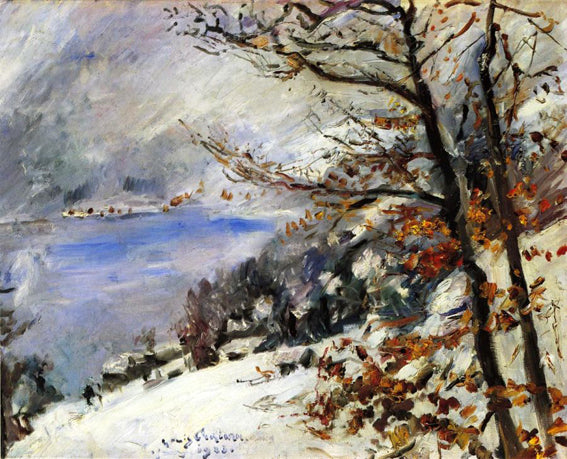Description
The work "The Walchansee in winter" by Lovis Corinth, created in 1923, is an eloquent example of the artist's ability to convey the majesty of nature through painting. In this piece, Corinth offers us a vivid and evocative representation of the winter landscape of the Walchesee Lake, a place where nature overflows in beauty, and the cold climate transforms the environment into a visual show of tones and shapes.
From the first glance, the composition of the painting is characterized by its focus on the lake, whose waters are presented in cold tones that reflect the ice and snow of the season. The surface of the water is partially frozen, which adds a unique texture, creating a contrast to the snow that covers the banks. This texture game is a distinctive feature in Corinth's work, which specializes in capturing the nuances of the environment through strong and gestural brushstrokes, which gives a sense of movement and depth to the landscape.
The bluish and gray tones dominate the palette, while flashes of pure white in the snow and the ice add luminosity to the scene. The way Corinth uses light is particularly notable. Subtle reflexes in the water and deep shadows in the rocks give life to the surface, creating a brightness effect that seems almost ethereal. This ability to handle light and shadow reflects the influence of impressionism, although the work is also immersed in the most personal and expressive style of the artist, which advocates a more subjective perception of reality.
One of the most intriguing characteristics of "The Walchansee in winter" is its apparent simplicity that, in the first place, could lead to an underestimation of the work. However, as the viewer examines more detail, he realizes the complexity of the representation of the environment. Not only is the lake and the surrounding landscape observe, but it feels an emotional connection with the cold of winter and a feeling of loneliness. This visceral response is a testimony of Corinth's ability to evoke emotions through its use of color and composition.
Lovis Corinth, a prominent representative of German expressionism, showed throughout his career a deep interest in the European landscape, and Walchensee was a recurring place in his work. The Lake Region, which is characterized by its impressive views and its surround atmosphere, served as an ideal scenario to capture the essence of the passage of stations and transformations of the natural environment. In this sense, "Walchansee in winter" is not only a painting of a place; It is an exploration of time, light and atmosphere that surrounds it.
This work is within a robust tradition of landscaping that refers to the connection between man and nature. Although there are no human figures presented at the scene, the absence of human characters can be interpreted as a comment on the relationship between the human being and the vast natural landscape, emphasizing the greatness and loneliness of this icy winter.
"The Walchansee in winter" is undoubtedly a work that invites contemplation. The fusion of Corinth's brilliant technique, his understanding of light and color, and his appreciation for natural landscapes are manifested in this magnificent representation. Painting is a testimony not only of its mastery as an artist, but also of its ability to capture the very essence of nature in its most introspective moments. In this way, the importance of Lovis Corinth is reaffirmed in art history, a painter whose work continues to resonate strongly in the contemporary artistic panorama.
KUADROS ©, a famous paint on your wall.
Hand-made oil painting reproductions, with the quality of professional artists and the distinctive seal of KUADROS ©.
Art reproduction service with satisfaction guarantee. If you are not completely satisfied with the replica of your painting, we refund your money 100%.

